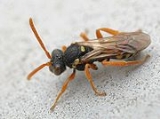
Nomadinae
Encyclopedia
The subfamily Nomadinae (e.g. Nomada
, Epeolus, Triepeolus, Holcopasites) is the largest and most diverse group of cleptoparasitic "cuckoo bees" with 31 genera in 10 tribes; they occur worldwide, and utilize many different types of bees as hosts. As parasites, they lack a pollen-carrying scopa
, and are often extraordinarily wasp
-like in appearance. All known species share the behavioral trait of females entering host nests when the host is absent, and inserting their eggs into the wall of the host cell; the larva
l parasite emerges later, after the cell has been closed by the host female, and kills the host larva. The first-instar
larvae of nomadines are specially adapted for this, and possess long mandible
s they use to kill the host larva, though these mandibles are lost as soon as the larva molts to the second instar, at which point it simply feeds on the pollen/nectar provisions. Another unusual behavioral habit seen in adults of various genera is that they will frequently "sleep" while grasping onto plant stems or leaves with only their mandibles.
Nomada
With over 850 species, the genus Nomada is one of the largest genera in the entire family Apidae, and the largest genus of cleptoparasitic "cuckoo bees." They occur worldwide, and utilize many different types of bees as hosts, primarily the genus Andrena...
, Epeolus, Triepeolus, Holcopasites) is the largest and most diverse group of cleptoparasitic "cuckoo bees" with 31 genera in 10 tribes; they occur worldwide, and utilize many different types of bees as hosts. As parasites, they lack a pollen-carrying scopa
Scopa (biology)
The term scopa is used to refer to any of a number of different modifications on the body of a non-parasitic bee that form a pollen-carrying apparatus. In most bees, the scopa is simply a particularly dense mass of elongated, often branched, hairs on the hind leg...
, and are often extraordinarily wasp
Wasp
The term wasp is typically defined as any insect of the order Hymenoptera and suborder Apocrita that is neither a bee nor an ant. Almost every pest insect species has at least one wasp species that preys upon it or parasitizes it, making wasps critically important in natural control of their...
-like in appearance. All known species share the behavioral trait of females entering host nests when the host is absent, and inserting their eggs into the wall of the host cell; the larva
Larva
A larva is a distinct juvenile form many animals undergo before metamorphosis into adults. Animals with indirect development such as insects, amphibians, or cnidarians typically have a larval phase of their life cycle...
l parasite emerges later, after the cell has been closed by the host female, and kills the host larva. The first-instar
Instar
An instar is a developmental stage of arthropods, such as insects, between each molt , until sexual maturity is reached. Arthropods must shed the exoskeleton in order to grow or assume a new form. Differences between instars can often be seen in altered body proportions, colors, patterns, or...
larvae of nomadines are specially adapted for this, and possess long mandible
Mandible (insect)
Insect mandibles are a pair of appendages near the insect’s mouth, and the most anterior of the three pairs of oral appendages . Their function is typically to grasp, crush, or cut the insect’s food, or to defend against predators or rivals...
s they use to kill the host larva, though these mandibles are lost as soon as the larva molts to the second instar, at which point it simply feeds on the pollen/nectar provisions. Another unusual behavioral habit seen in adults of various genera is that they will frequently "sleep" while grasping onto plant stems or leaves with only their mandibles.

